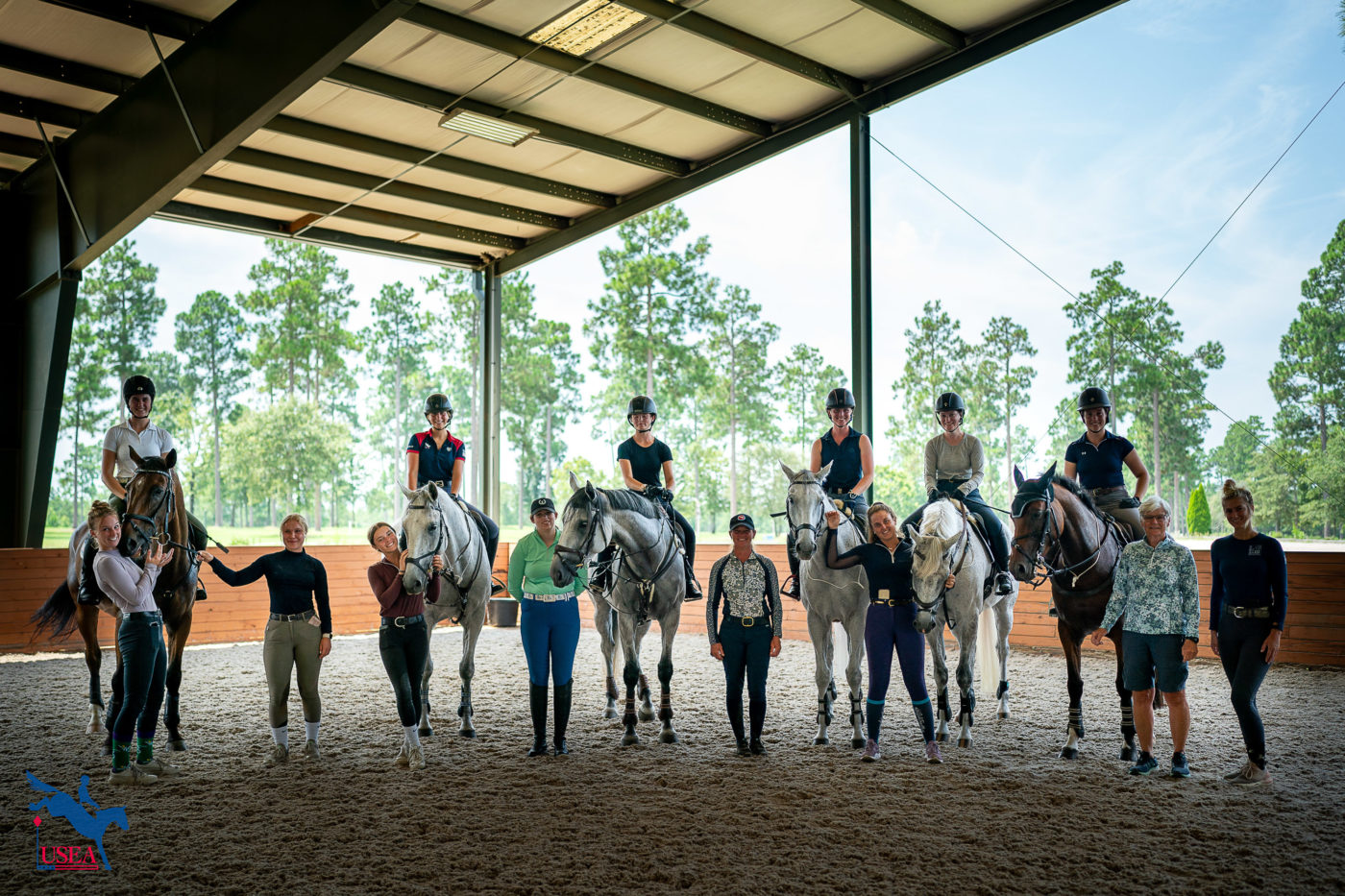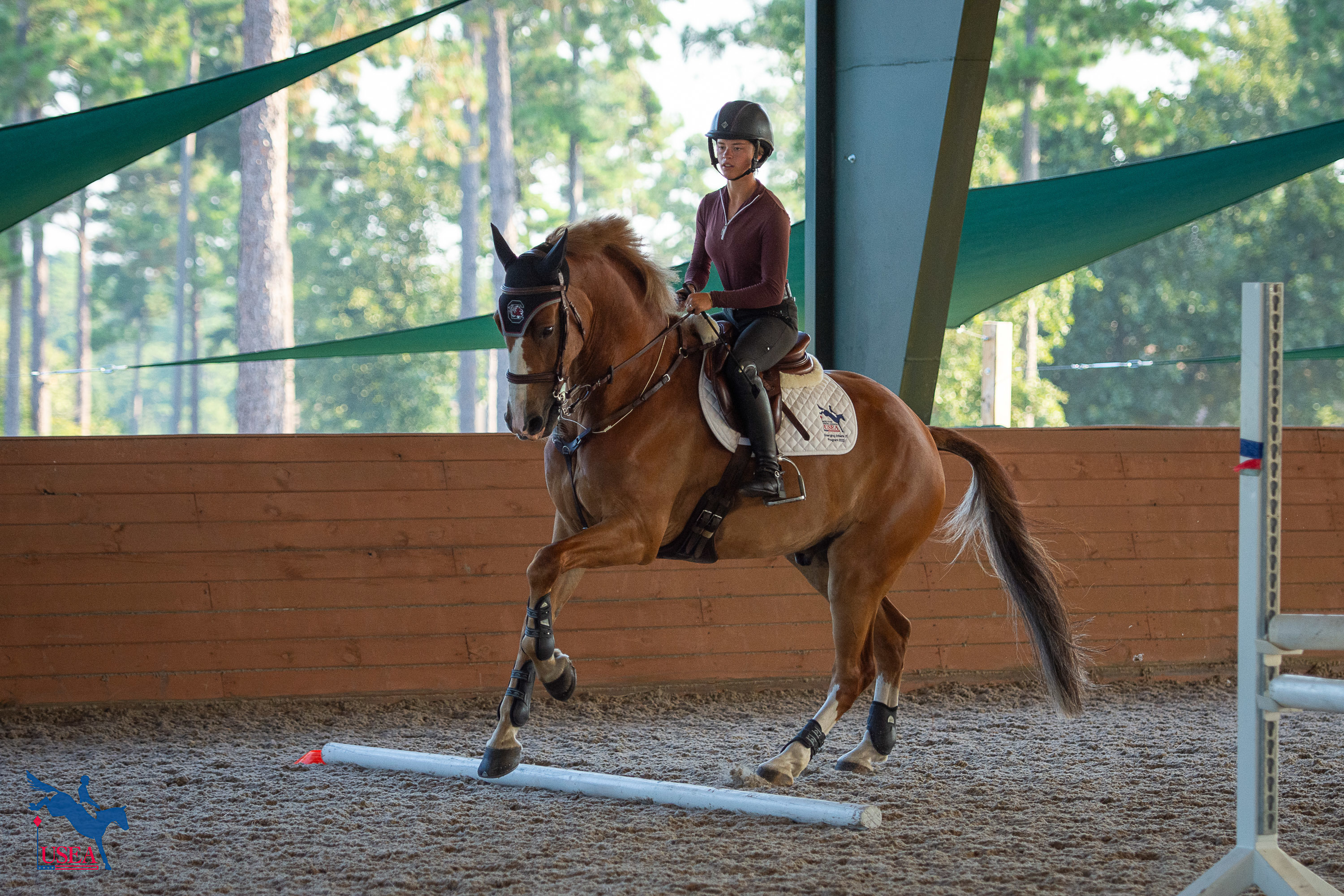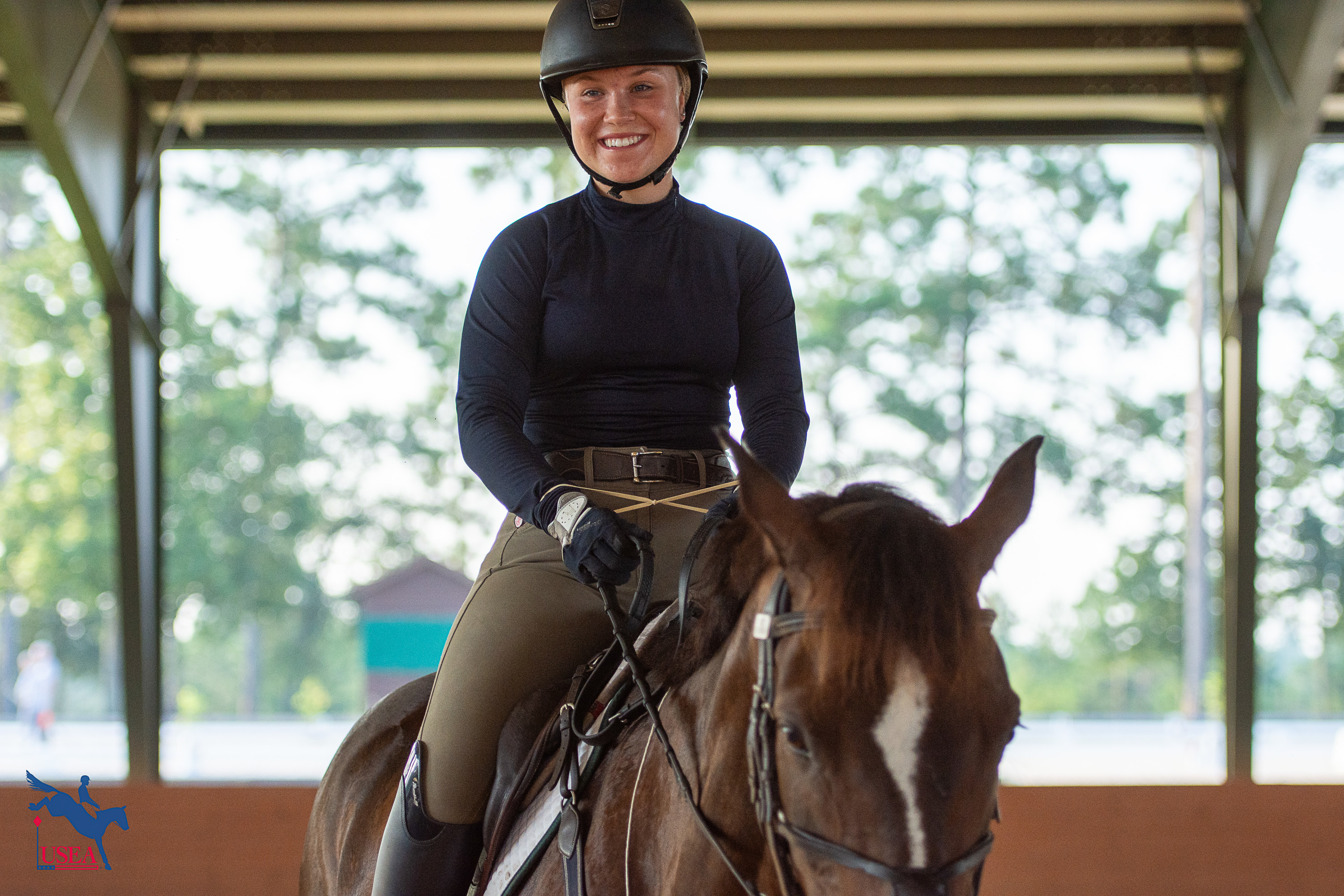Renew Your USEA Membership for the 2023 Season Today LEARN MORE

Tuesday’s building blocks laid a strong foundation for riders to grow from on the second day of the USEA Emerging Athlete (EA21) East II Clinic, held at Stable View in Aiken, South Carolina. Similarly to the first day, clinician Emily Beshear explained that her goal was to give riders a variety of tools for a variety of situations—some which might solve problems today, but others that may come in handy in the future.
All participants started with four poles on the ground in a circle. Starting at the trot, riders were asked to trot on the outer edge of the pole to create a large circle, then on the very inside of the poles to create a much smaller circle, controlling the horse’s shape throughout.
“The circle is very straightforward, but we can do a lot with it. My thinking when I do single trot poles is that I want them to maintain the line that I’m choosing and the frame that I’m choosing. I don’t want them drifting to the side or losing their outline if they need to take a bigger step over the pole,” Beshear explained.

Even when the focus shifted to jumping, Beshear kept the “Dollar Store Training Tools” from day 1 in play. She started day two with two rubber bands tied together looped over each riders wrist, connecting in the middle to force riders to focus on turning the horse with their seat and leg rather than their hands.
With the rubber bands in place, Beshear also had riders loop a pinky through a neck strap made of twine—another Dollar Store find. “The challenged version is to do the whole thing in two-point with your pinky through your neck strap. I want you to feel comfortable that you can ride with your seat through the hand. The slower the gait, the harder it is to hold your position in two point. Have your hands a little further forward than you did the first time. It also challenges your balance,” she said.
Changing the riders’ seat forced them to rely even more on their leg and seat to produce a nice frame while managing the circle. “With the reins short and your hands out in front of you. You’re staying to him ‘take me here’ and because we’re doing this at the trot it’s really obvious if he’s actually taking you forward or if he’s just up and down. It’s a different version of how you’re using your aids,” Beshear explained.
For horses that became tense or anticipated the upcoming ground poles, Beshear encouraged riders to focus on elasticity in their position. “On one that might get a little excited, think about staying really flexible in your joints. You can also play around with your position to make them more comfortable,” she said.

Still on the circle, Beshear asked participants to canter with the rubber bands still around their wrists while putting their heels, rather than the ball of the foot in the stirrup, to encourage them to stretch their leg down beneath them while sitting the canter in a full seat.
“When you’re in full seat, sometimes we can get in the habit of just always having your leg on there, but this forces you to think about pushing your weight down in your heels because if you don’t you’ll lose your stirrup,” she explained.
Next, riders tackled a line of groundlines set at 18' distances. “I would consider this a somewhat compressed show jumping canter,” Beshear said, adding that for her own horses she sets a one-stride distance anywhere from 15'-21'. “I want you to figure out the right canter for this space, and the poles continuing will help you find consistency.”
These poles also had cones set up in the middle of each pole, and at the trot riders first came through the line leg yielding around each cone. “Use this as a lateral balancing exercise. You want to keep [the horse] relatively straight, and find small lateral shifts. It’s only a slight shift, but you want to figure out what aids can get them to shift their body just that much. These are the same aids you would use to make sure their body makes it through the flags over a corner on cross country,” Beshear stated.
This exercise also tested the rider’s ability to control the lateral work. Beshear explained that most horses tend to want to continue in the direction that you’ve started to send their body, and moving them back and forth forces riders to control the step. “If they bulge laterally, you’ll find it’s even harder to go back the other way. This trains your ability to show them to ‘go here and stay right here,’” she clarified.
From here, Beshear turned the last groundline into the oxer to introduce jumps. This progression, she explained, can help riders find the correct feel of a half halt.
“Between the combination of your half halt and how can I shift them side to side. There’s a lot and it might feel a little awkward but it’s going to help your feel in developing control of their body. I want this to help you guys feel the rhythmic nature of the half halt. And you want to work out where is the best spot to influence them,” she said.
The final portion of each group concluded with course work where riders could implement the tools introduced in earlier sections.
“This helped you feel the missing links, which I thought was cool,” said EA21 rider Alina Patterson. “And then the grid work established their cancer, and a really nice rhythm throughout, so when we did go to the single jumps, we had that to build off of. We could keep the feel of what we created in the grid with the polls before, which I thought was really helpful.”
Rider’s echoed Patterson’s sentiment, and agreed the “Dollar Store Training Tools” made them think outside the box.
“It was kind of experimenting,” Patterson said. “We did some fun things with our stirrups and reins, and I thought it was beneficial because we were able to really feel if the horses were on our seat and leg instead of so much on our reins. I thought it could really point out the weaknesses and what we needed to focus on.”
The 12 riders here at Stable View, as well as all the riders from the four other regional camps, will now be considered for the opportunity to participate in the national camp with EA21 Director of Coaching, David O’Connor, which will be held in January 2024.
About the USEA Emerging Athlete U21 Program (EA21)
The purpose of the USEA Emerging Athletes U21 Program (EA21) is to identify and provide consistent quality instruction to the next generation of elite event riders. The aim is to create a pipeline for potential team riders by identifying and developing young talent, improving horsemanship and riding skills, and training and improving skills and consistency.
The USEA Emerging Athletes U21 Program was launched in 2022 with a model of five summertime regional clinics taught by selected USEA Eventing Coaches Program (ECP) instructors, leading to a winter national camp consisting of selected Young Riders from the regional clinics. Athletes who are 21 years or younger, are current members of their USEA Young Rider Area program, and are established at the Training Level or higher, are eligible to apply for the EA21 program. Click here to learn more about the USEA EA21 Program.
The USEA would like to thank Kerrits, Ride iQ, Sidelines Magazine and WeRideTogether for sponsoring the USEA Emerging Athletes U21 Program.